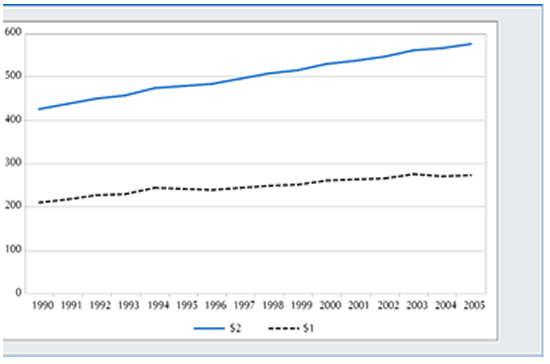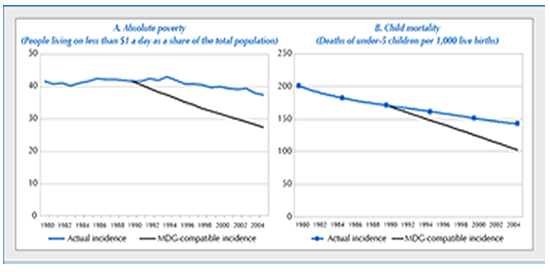| EMBARGO The contents of this press release and the related Report must not be quoted or summarized in the print, broadcast or electronic media before 17 July 2008, 17:00 [GMT] (1pm New York; 19:00 Geneva) |
Exceptional economic performance failing to reach broad populations; global food crisis will likely worsen situation, study says
Geneva, 17 July 2008 - The highest rate of economic progress in the world´s 50 least developed countries (LDCs) in the last 30 years has not been enough to prevent their total number of poor from increasing, a new UNCTAD report reveals. Three fourths of those living in these nations continue to survive on less than US$2 a day. Recent rising food costs are threatening to undercut the modest progress achieved, the report adds.
Overall economic growth rates of 7% and more in the LDCs in 2005-2006 should have provided an opportunity for substantial improvements in living conditions, the Least Developed Countries Report 2008(1) says - but rapid population increases and other factors mean some 581 million people continue to live in material deprivation out of a total LDC population of 767 million in 2005 (see Chart.1). Income of under US$2 per day does not allow most to meet basic needs for food, water, shelter, health, or education.
This year´s Least Developed Countries Report is subtitled "Growth, poverty and the terms of the development partnership."
The report finds that despite high growth in LDCs in recent years, inhabitants´ well-being has improved only slowly. Economic growth has had some impact on absolute poverty, the most extreme form of material deprivation. "Absolute poverty" refers to those living on less than $1 a day. The share of the overall LDC population (the so-called poverty rate) living below this income level declined slowly from 44% in 1994 to 36% in 2005, according to new poverty estimates made by UNCTAD. This level is still high and amounts to 277 million people (see chart). Although the incidence of poverty has declined, the absolute number of poor rose owing to high population growth. Even with faster economic growth, the number of those living in absolute poverty rose until 2003 and then stabilized. However, the number of poor living on more than $1 a day but less than $2 a day continues rising.
Slow progress in reducing poverty means the LDCs will not be able to achieve the first of the United Nations´ Millennium Development Goals (MDGs): halving the proportion of those living on less than $1 a day between 1990 and 2015. To achieve the poverty goal of MDG 1, the LDCs would need to cut their absolute poverty rate to 20% by 2015. UNCTAD projections show that if current trends continue, LDCs will only achieve 33% by that date. The global food crisis is projected to worsen the situation (see below).
The incidence of poverty and the rates at which it has been falling are quite different between African and Asian LDCs. As much as 80% of the populations of African LDCs live on less than $2 a day, while the proportion is 69% in Asian LDCs. This amounts to 375 million poor in African LDCs and 204 million in the Asian LDCs, with a further 2 million living in island LDCs. Asian LDCs have been more successful in reducing poverty because they have been able to create jobs at a much faster pace, the report says.
Progress in other aspects of human well-being is also slow
Economic growth has been accompanied by sluggish progress towards achieving other so-called human development goals related to nutrition, health, education, gender equality, and environmental sustainability. Most LDCs will probably be unable to meet most of the MDGs by 2015 (see Chart.2).
LDCs have achieved most progress in areas where they have sharply increased social spending by national governments with the backing of donor countries and/or international non-governmental organizations (NGOs), all acting through well-targeted programmes, the report says. Progress has been strongest in increasing the level of primary education, followed by widening access to safe water and improved sanitation. (However, even in the case of primary education, 43% of LDCs are unlikely to meet their MDG target by 2015.) By contrast, achievements that are more dependent on private income - such as reducing poverty and hunger - have been more limited.
The main reasons strong economic growth fails to translate into hefty improvements in well-being are the types of growth and the models of development that LDCs have been following, the report says (see press release UNCTAD/PRESS/PR/2008/012). These approaches mean only limited segments of the population benefit from economic expansion. Job creation has been limited - particularly in African countries - which deprives most people of direct increases in their earnings. Another factor making social progress difficult is strong population growth.
Global food crisis threatens to reverse even slow social progress achieved so far
Sharp spikes in international food prices in 2007 and early 2008 have led domestic food costs to soar in LDCs. In some, the prices of staples such as maize, wheat, and rice have doubled in one and one-half years. Since most people in LDCs are poor and a large share of their income is spent on food, they have been hit hard by rising prices. This situation resulted in food riots in eight LDCs between 2007 and the first half of 2008 (Burkina Faso, Guinea, Haiti, Mauritania, Mozambique, Senegal, Somalia, and Yemen). Two thirds of LDCs import more food than they export.
Higher food prices have compressed poor families´ already tight budgets. They can afford fewer other products and increasingly buy lower-quality food, thus raising the danger of malnutrition. That, in turn, will have adverse consequences for health and education. The food crisis is threatening to roll back even the slow progress the LDCs have achieved in their populations´ overall well-being, the report warns.
ANNEX
Tables and figures
Chart.1 - Estimated number of poor in LDCs, 1990-2005 (Million)
Source: UNCTAD, Least Developed Countries Report 2008
Note: $1 - Number of people living on less than $1 per a day.
S2 - Number of people living on less than $2 per a day.
Chart.2 - Poverty and child mortality in LDCs: Actual and MDG-compatible incidence, 1990-2005 
Source: UNCTAD, Least Developed Countries Report 2008
Note: The charts above show how far LDCs are from the path leading towards the MDGs. Starting from 1990, the lower line shows how poverty and child mortality should evolve if LDCs were to reach the corresponding MDGs by 2015; the upper line show the actual path. The gap between the two lines is widening, showing how much these countries are off track.


